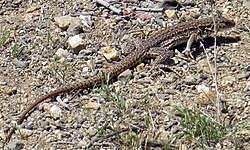| Callopistes Temporal range: | |
|---|---|
 | |
| False monitor (Callopistes flavipunctatus) | |
| Scientific classification | |
| Kingdom: | Animalia |
| Phylum: | Chordata |
| Class: | Reptilia |
| Order: | Squamata |
| Suborder: | Lacertoidea |
| Family: | Teiidae |
| Subfamily: | Callopistinae |
| Genus: | Callopistes Gravenhorst, 1838 |
| Species | |
| |
Callopistes is a genus of lizards in the family Teiidae. The genus contains two extant species, which are native to Ecuador, Peru, and Chile, as well as two fossil species found in Argentina.

